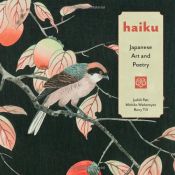Haiku: Japanese Art and Poetry
Blurb
The strictest and purest of poetic forms, the Japanese haiku contains in its seventeen sound characters a reference to a season as well as a distinct pause or interruption. Cherry blossoms and swallows might refer to spring; red maple leaves and deer usually imply autumn. These seasonal allusions emphasize the essence of haiku: nature and its ephemeral beauty.
The graceful, evocative haiku featured here were composed by the renowned Japanese haiku masters of the past four hundred years, including Matsuo Basho, Taniguchi Buson, and Kobayashi Issa. The deceptively simple poems--rendered in English with Japanese calligraphies and transliterations--are paired with exquisite eighteenth- or nineteenth-century paintings and ukiyo-e prints and twentieth-century shin hanga woodcuts from the Art Gallery of Greater Victoria, Canada. With their depth and delicacy, wide range of subtle hues, and time-honored focus on landscapes, birds, and flowers, these artworks--like their haiku counterparts--quietly capture a moment in time.
Haiku: Japanese Art and Poetry presents thirty-five pairs of poems and images, organized seasonally. The Introduction details the origin and development of haiku, the lives of the most famous poets, and the obstacles faced when translating the concise yet complex lines.

 English
English Español
Español Deutsch
Deutsch










Member Reviews Write your own review
Be the first person to review
Log in to comment